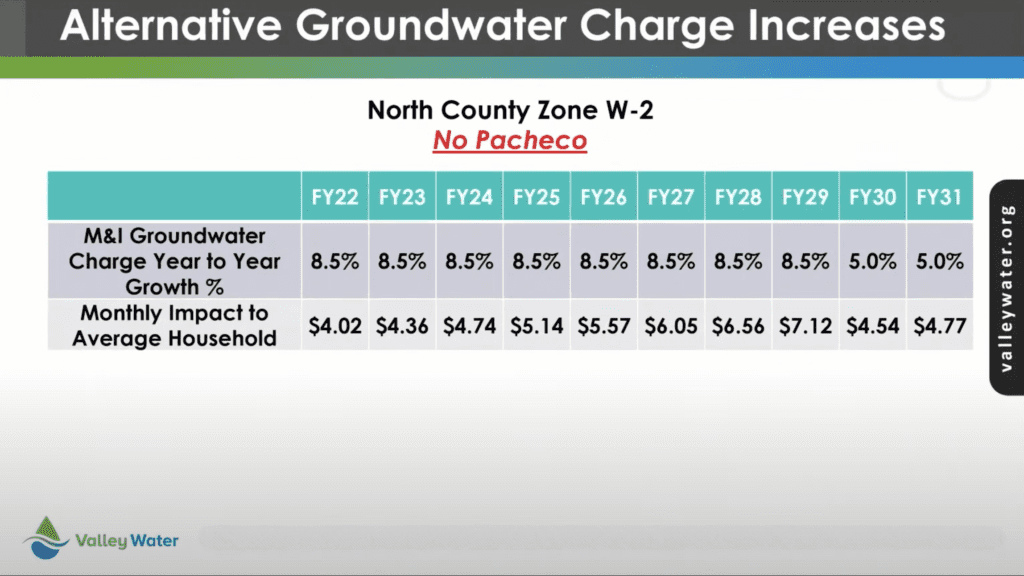The Santa Clara Valley Water District, the wholesale water provider for the county, approved water rate hikes in a unanimous vote by its directors Tuesday.
Valley Water provides water to the San Jose Water Company, the San Jose Municipal Water System and the Great Oaks Water Company, who then sell the water to residents. It also provides flood protection, manages three water filtration plants and several dams in the county.
According to a board presentation, the vote will raise rates by up to 9.1%, an approximate $4.30 to $5.10 increase per month to customers. Plans were originally set for last year but were put on hold due to the pandemic. Now, with an impending drought, Valley Water said it needs to act more urgently.
“We are truly in an emergency,” said Valley Water Chief Executive Officer Rick Callendar on Tuesday. “These are part of the solutions in addressing the emergency.”
Rate hikes would take effect July 1.

The increased rates will help the district buy water and help fund infrastructure projects, according to the district.
The San Jose City Council voted unanimously last month to ask Valley Water to stop any rate increases. Since Valley Water is an independent agency, it does not have to comply with the city’s requests.
The rate increases mean that rates for local companies like the Great Oaks Water Company, San Jose Water and the San Jose Municipal Water System are likely to increase their rates to make up for the rate hikes.
Residents on Tuesday worried that rates would continue to increase in the future, leaving no end in sight.
“I think water is really important,” said Brian, a local resident. He declined to give his last name. “It just seems like there’s costs all the time—up and up and up.”
The state is heading toward another drought and Valley Water says the increase to help fund projects like the Pacheco Dam will help protect a scarce water supply for the future.
San Jose Mayor Sam Liccardo announced Thursday he would oppose Valley Water’s estimated $2.5 billion proposed dam and reservoir in Pacheco Pass, saying the project is too costly and provides little benefit to residents.

According to an April 14 Valley Water report, rate hikes would drop to 8.5% a year if the Pacheco Pass project is not built. It also concluded the new dam would not bring a new water supply because the area receives little rainfall. It would however store imported water from the nearby delta, which will help with short-term droughts.
“We believe there are lots of alternatives to get safe, reliable water, particularly during what we know is a tough period ahead,” Liccardo said. “This (Pacheco Pass) project ain’t going to save us.”
Tomorrow May 11, the Board of Directors for Santa Clara Valley Water District will vote to increase wholesale drinking water rates by almost 10% every year for the next decade—for a total 146% increase. (1/2)https://t.co/WZgpAeVUIM
— Sam Liccardo (@sliccardo) May 10, 2021
The original budget ballooned by more than $1 billion after engineers found that they needed to bore at least 30 feet deeper than expected to ensure the dam’s stability.
Katja Irvin, who represents Sierra Club’s local chapter, said she’s been opposing the Pacheco Pass project and water rate hikes, but seemingly to no avail.
“I’ve been doing this for 10 years, and I’ve never seen any impact from any impact from any comment I’ve ever made,” Irvin said. “The costs for Pacheco are going to go up.”
Valley Water also concluded that two other proposals—raising the height of the dam at Los Vaqueros Reservoir in Contra Costa County or raising the dam at San Luis Reservoir near Gilroy—could be done for roughly half the cost of Pacheco.
Valley Water is looking to offset costs for its projects from federal funding and is working to reduce costs on other proposed projects. Valley Water officials said that increasing costs for building and maintaining dams has made that difficult.
Valley Water officials said they’ll do more community outreach for the dam project, which began earlier this year. Officials expect to have a draft environmental impact report by the end of 2021, along with more grants to help pay for the project.
The dam, expected to be completed in 2034, will be located north of State Highway 152 near Henry W. Coe State Park. It would hold up to 144,000 acre-feet of water, much larger than the current 5,500 acre-feet of water.
“We’re increasing the rates, and we’re going to continue to do our due diligence on Pacheco,” Valley Water District 3 Richard Santos told San José Spotlight.
Contact Lloyd Alaban at [email protected] or follow @lloydalaban on Twitter.
Editor’s Note: Valley Water CEO Rick Callender serves on San José Spotlight’s Board of Directors.



Leave a Reply
You must be logged in to post a comment.